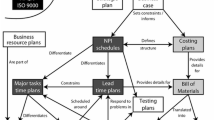Abstract
The purpose of this paper is to propose a new approach for modeling project activitiesand networks of project activities based on a digital circuit metaphor upon which a projectscheduling tool could be built. Each activity is represented by one or more digital circuitelements where the inputs to the elements are the requirements that must be satisfied beforethat activity can begin. We demonstrate that our model has all the capabilities of traditionalmodels such as PERT/CPM. We then extend our model to incorporate additional featuresnot currently supported by most traditional models. We illustrate the use of AND, OR,NAND, NOR, and XOR gates in the creation of a project network and show how combina-tionsof these elements can be used to represent arbitrarily complex activity requirements.Finally, we discuss how our model could be used to create an open, flexible, extendible anddistributable project planning tool that supports continuous process improvement. The paperpresents the model and how it was developed as an analogue of digital circuit design. Thus,it serves two audiences: those interested in the modeling process and those interested in anovel approach to project scheduling.
Similar content being viewed by others
15. References
D. Brown, J. Marin and W. Scherer, A survey of intelligent scheduling systems, in: Intelligent Scheduling Systems, eds. D. Brown and W. Scherer, Kluwer Academic, 1995, pp. 1–40.
R.E. Carlyle, Where methodology falls short, Datamation 34(1 December 1988)43–46.
B. Curtis, M.I. Kellner and J. Over, Process modeling, Communications of the ACM 35(September 1992)75–90.
W. Delaney and E. Vaccari, Dynamic Models and Discrete Event Simulation, Marcel Dekker, 1989.
T. DeMarco, Controlling Software Projects, Yourdon Press, 1982.
S. Elmaghraby, An approach to the modeling and analysis of software production processes, International Transactions of Operational Research 2(January 1995)117–135.
R.L. Flood and S.A. Robinson, Analogy and metaphor and systems and cybernetics methodology, Cybernetics and Systems: An International Journal 19(1988)501–520.
L. Fried, The rules of project management, Information Systems Management 9(Summer 1992)71–74
A.M. Geoffrion, An introduction to structured modeling, Management Science 33(1987)547–588.
V. Gruhn, Validation and verification of software process models, European Symposium Proceedings on Software Development Environments and CASE Technology, 17-19 June 1991, pp. 271–286.
P. Haddawy and L. Rendell, Planning and decision theory, Knowledge Engineering Review 5(March 1990)15–33.
N.R. Jennings and M. Wooldridge, Applying agent technology, Applied Artificial Intelligence 9 (1995)357–369.
C.V. Jones, Anchoring and cross-fertilization, ORSA Journal in Computing 6(1994)278–280.
G. Knotts, M. Dror and B. Hartman, A project management tool for computer-supported cooperative work during project planning, The Proceedings of the 31st Hawaii International Conference on System Sciences, Vol. 1, January 1998, pp. 623–631.
I. Kurtulus and E. Davis, Multi-project scheduling: Categorization of heuristic rules performance, Management Science 28(1982)161–172.
G.S. Lee and T. Murata, A β-distributed stochastic Petri net model for software project time/cost management, Journal of Systems Software 26(1994)149–165.
J.J. Moder, C.R. Phillips and E.W. Davis, Project Management with CPM, PERT, and Precedence Diagramming, 3rd ed., Van Nostrand Reinhold, 1983.
T.E. Morton and D.W. Pentico, Heuristic Scheduling Systems With Applications to Production Systems and Project Management, Wiley, 1993.
OTR Group Report detailed in Computer Weekly (12 December 1992) p. 8.
L. Ozdamar and G. Ulusoy, A survey on the resource-constrained project scheduling problem, Industrial Engineering and Research and Development 27(1995)574–586.
J.L. Peterson, Petri Net Theory and the Modeling of Systems, Prentice-Hall, 1981.
R. Rosen, Anticipatory Systems: Philosophical, Mathematical, and Methodological Foundations, Pergamon Press, 1985.
J.W. Rozenblit, Design for autonomy: An overview, Applied Artificial Intelligence 6(1992)1–18.
M. Sargent, III and R.L. Shoemaker, The Personal Computer from the Inside Out, 3rd ed., Addison-Wesley, 1995.
L. Schruben and E. Yucesan, Modeling paradigms for discrete event simulation, Operations Research Letters 13(1993)265–275.
A. Shtub, J.F. Bard and S. Globerson, Project Management: Engineering, Technology, and Implementation, Prentice-Hall, 1994.
J.F. Wakerly, Digital Design Principles and Practice, Prentice-Hall, 1990.
L. Willcocks and C. Griffiths, Predicting risk of failure in large-scale information technology projects, Technological Forecasting and Social Change 47(1994)205–228.
Rights and permissions
About this article
Cite this article
Knotts, G., Dror, M. & Hartman, B. A project scheduling methodology derivedas an analogue of digital circuit technology. Annals of Operations Research 82, 9–28 (1998). https://doi.org/10.1023/A:1018995610856
Issue Date:
DOI: https://doi.org/10.1023/A:1018995610856




